It was a beautiful day yesterday, with high, wispy mares’ tails clouds, all day.
The house martins were so high in the sky they were barely visible. Glorious.
It was a beautiful day yesterday, with high, wispy mares’ tails clouds, all day.
The house martins were so high in the sky they were barely visible. Glorious.
I love nature jewellery, inspired by birds or flowers or animals. And it seems appropriate as beach time is on us that I have a lot of shell jewellery at the moment, either made from shells or depicting them. All are for sale in my Etsy shop: click on the photos for details.
Shelly, pearly, silvery, nacreous loveliness.
One of the features of the ‘dashboard’ for this blog is a list of the search terms that visitors have used to bring them here. In among the usual ‘Niels Erik From’ and ‘Scandinavian silver’ and ‘filming locations’ search terms, yesterday I spotted something a little more unusual: ‘Tree with flowers like cow parsley’. Now I don’t know the nationality of the searcher, but I’m assuming they are British as cow parsley (Anthriscus sylvestris) is one of our common wildflowers here. And so I’m guessing they might be searching for a British native tree with flowers like cow parsley.
My immediate thought was the elderflower, Sambucus nigra. It is in blossom right now, and looking glorious. Great frothy heads of white and creamy white flowers cover the large shrub/small trees.
Often the cow parsley is out at the same time that the hawthorn (Crataegus mongyna) is in blossom, their intertwangled blooms giving a white frothy appearance to the hedgerows and roadsides around here, but this year the cow parsley has been much later in flowering. It’s just about going over now, but has overlapped with the elderflower blossoms, giving a different but equally lovely combination of white froth.
In our garden we grow an elderflower cultivar, a stunning and decorative form with purple leaves and light mauvey pink flowers, Sambucus nigra f. porphyrophylla ‘Eva’. (It was called Sambucus nigra ‘Black Lace’ when I bought it, but as so often seems to be the way with horticultural nomenclature, it’s undergone a name change, and is now a bit more of a mouthful).
Now is the time of year to make elderflower cordial, a delicious and refreshing drink made from the blossoms. Here’s a recipe by Jane Hornby from the BBC Good Food website:
Elderflower cordial
Makes about 4 litres
Ingredients
20 fresh elderflower heads, stalks trimmed
2.5 kg granulated or caster sugar
2 lemons, unwaxed
85 g citric acid (available from chemists)
Put the sugar and 1.5 litres water into a very large saucepan – a jam pan is best. Gently heat until the sugar has dissolved, but do not allow to boil. Pare the zest from the lemons, then slice the lemons into rounds.
When the sugar has dissolved to make a syrup, bring it to the boil then remove from heat. Wash the elderflower blossoms to remove insects or dirt – a washing up bowl full of water will do the trick nicely. Shake the flowers dry gently and add to the syrup along with the citric acid, lemon zest and lemon slices. Stir well. Cover the jam pan and leave for 24 hours for all the flavours to infuse into the syrup.
Drain the syrup (now transformed into cordial) and flowerheads through a clean piece of muslin or tea towel lining a colander, which sits over another large container. Discard what’s left in the muslin and put the cordial into sterilised bottles (these can be sterilised by putting them through the dishwasher on its hottest setting, or by washing well with very hot soapy water, rinsing and leaving in a low oven to dry). The cordial is ready to drink. Serve by diluting to taste with water, soda water, tonic water or whatever you fancy. It will store for up to six weeks in the fridge. It can also be frozen (ice cube trays are great for individual portions) and used as needed.
Yesterday Chap and I headed off to the main part of Fontmell Down Nature Reserve, which is run by Dorset Wildlife Trust and situated about 5 km south of Shaftesbury in Dorset. Fontmell Down is a spur of chalk downland jutting out above the Blackmore Vale. The spur is bisected by two cross dykes, landscape features that are likely to date from the Middle Bronze Age. We visit this reserve often, but it is at its beautiful best this time of the year, we reckon. Click on all photos to embigggen/bigify.
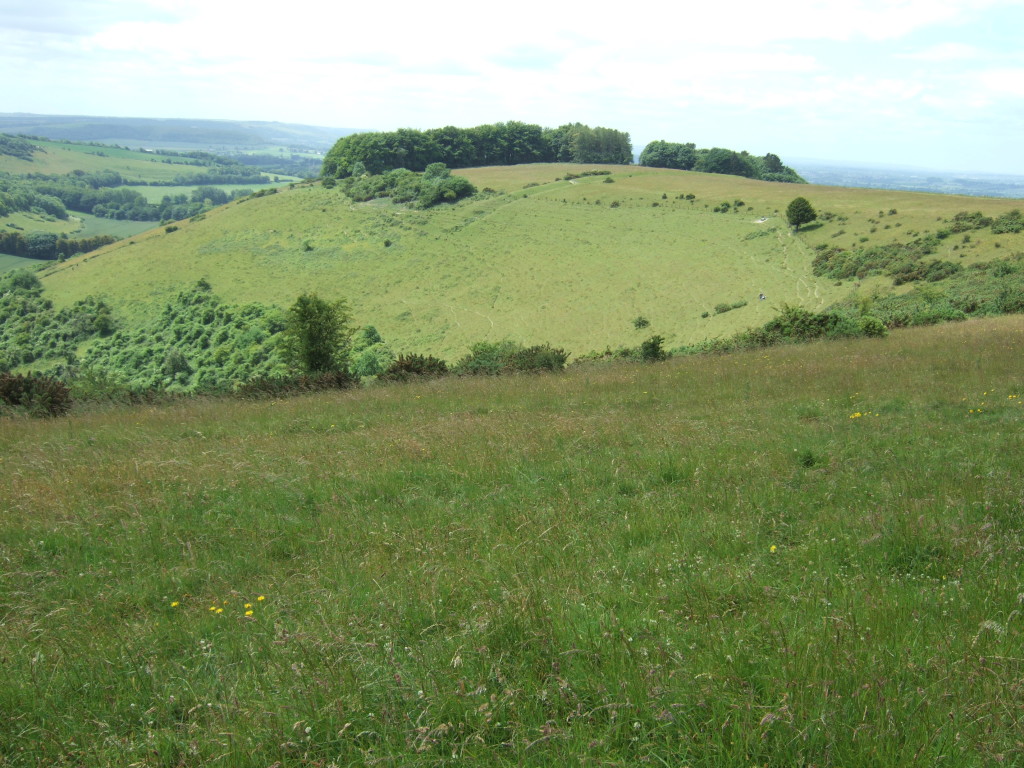
The spur of Fontmell Down, part of the chalk downland above the Blackmore Vale in Dorset. The northern cross dyke is clearly visible, just in front of the woodland on the spur. The southern one is obscured by the wood.
The orchids are out and within a few minutes of being on the reserve we’d seen five different species: bee, common spotted, fragrant, pyramidal and the greater butterfly orchid.
Viper’s bugloss (Echium vulgare) is such a pretty flower. It is a glorious blue, and beloved of moths and butterflies and bees. It doesn’t grow very high on the thin soil of the chalk downland, but I have seen it growing up to about 80 cm tall.
We also saw milkworts (Polygala sp.) in pink and in blue, and the wonderfully vibrant flowers of birdsfoot trefoil (Lotus corniculatus). We always called this ‘the eggs and bacon plant’ when we were kids, for obvious reasons!
There were also the enormous seedheads of goatsbeard (Tragopogon pratensis), like dandelion clocks on steroids. Goatsbeard flowers only open on sunny mornings, so the flower gained the charming folk name of Jack-go-to-bed-at-noon.
It was a rather blustery day, so we didn’t see too many butterflies, but we did see some fritillaries and a rather tatty painted lady (Vanessa cardui), as well as various blues and skippers.
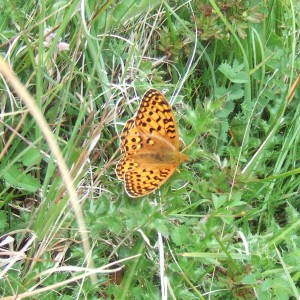
A fritillary. I’m not very good on butterflies, but think this might be a dark green fritillary (Argynnis aglaja).
We also saw this chap – isn’t he wonderful? No idea what he is.
The beautiful down has a deep coombe on its southern side, Longcombe Bottom, with ravens flying over, cronking their atmospheric calls
and there are stunning views to the south-west across the Blackmore Vale:
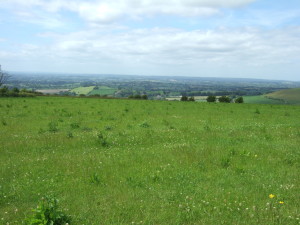
View looking south-east into Blackmore Vale, with the village of Fontmell Magna in the foreground of the vale.
We also walked on down to a chalk pit hollow nearby, where there was the best show of orchids. Just common spotted and pyramidal, but so beautiful.
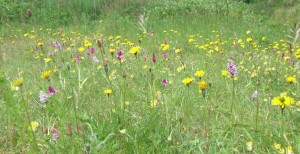
The orchids in the chalk pit hollow: pyramidal orchids (Anacamptis pyramidalis) and common spotted orchids (Dactylorhiza fuchsii). Definitely click on this one to embiggen/bigify – it’s worth it, I promise!
A water pipeline has recently been built across the reserve, and it was interesting to see the different flowers that have popped up in the disturbed area: lots of oilseed rape and common poppies and thistles, whereas the undisturbed land was mainly cow parsley and nettles.
The northern cross dyke had more orchids than on the other parts of the down, because the ditch provides a sheltered microclimate.
A beautiful thistle. Not sure which kind, but what a gorgeous colour.
Yesterday evening Chap and I and our lovely neighbour T were sitting in the garden enjoying a glass of wine. The clouds were high, wispy cirrus ones, and the evening sun was wonderfully warm (we’ve been having quite a cold spell, so this was doubly welcome). I’d been commenting earlier to Chap how the conditions were similar to those on the day we’d seen a circumzenithal arc and sun dog last year … and sure enough, about half an hour later, there was a sun dog!
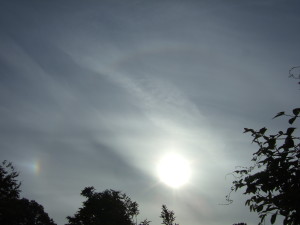
Sun dog to the left of the sun, together with the 22° halo. West of Salisbury, Wiltshire, 16 June 2015, 6.30 pm.
This time it was a left sun dog together with a 22° halo around the sun. Fantastic!
Mind you, it doesn’t quite match up to this amazing image, taken earlier this year in New Mexico, United States:
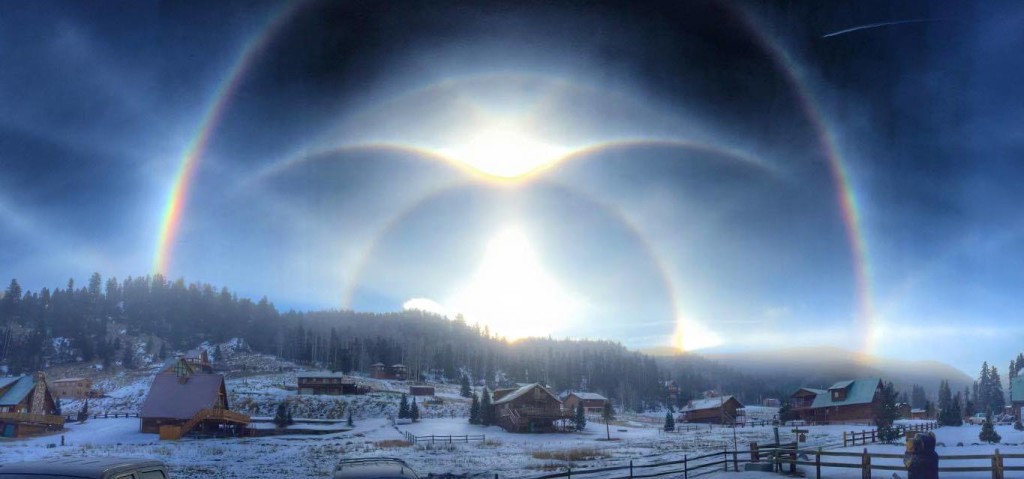
There are nine separate atmospheric optical phenomena visible in this amazing photo by Joshua Thomas. Taken at Red River, New Mexico, USA on 9 January 2015.
And here’s an explanation of what you can see:
Oooweeee, I listed two new Niels Erik From pieces in my Etsy shop today, bringing my total to eleven. Don’t they look good together?

Niels Erik From (N E From) silver jewellery for sale in my Etsy shop right now. Don’t they look good together? Click on photo for details.
I did an earlier post about him here, with information about his silversmithy, designs and maker’s marks.
Love me some Niels Erik Frommery!
23 June UPDATE: Blimey, I’m not the only one who loves a bit of Niels Erik action – since posting this on 16 June, three of my last six sales have been his pieces. He’s a popular chap, that’s for sure.
1 July UPDATE: Make that four of the last seven sales! I am adding N E From pieces all the time, so do keep looking.
Ah, this is great news. The European Space Agency‘s lander on (deep breath) Comet 67/P Churyumov-Gerasimenko has woken from its sleep. It landed on the surface of the comet last November, launched from the space probe Rosetta, but bounced on landing after its anchoring mechanisms failed, and ended up in a deeply-shaded ditch. As its solar panels didn’t then receive enough sunlight to generate power, it went into hibernation after sending back a small amount of information. However, the comet has since moved closer to the sun and is receiving more sunlight, and as the scientists had hoped, Philae has started working again and is able to send messages back to earth, via Rosetta, which is still orbiting the comet.
Yay! So exciting! Lots of fantastic science experiments to come. Drilling! Analysing! Hurrah!
I’ve written two posts previously about a mystery tile of mine, one that was similar to an Iznik tile design, but not quite right for a confident identification as such. The first post is here, where I describe the tile, and the second is here, where I went in to a bit more detail about possible Iznik parallels. The skilled ceramists of Iznik in Turkey produced exquisite tiles, tableware and other decorated and glazed objects from the last quarter of the 15th century until the end of the 17th century AD.
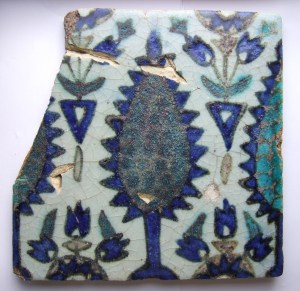
The mystery tile. 22 cm x 22 cm.
The Iznik tiles didn’t quite match my tile, though. The interior of the flower spike in the Iznik examples have a painted fish-scale like decoration motif, whereas my tile had less-defined lumpy blobs with a fuzzier appearance. The background underglaze colours were different too: a crisper whiter colour in the Iznik examples versus the bluey-greyish off white of my tile. So it seemed likely that these were takes on the same design by different ceramic producers. Was one a copy of the other? I would assume mine was a copy of the Iznik tile, as it is less refined and cruder in execution.
After I wrote the second post I contacted Anthony Slayter-Ralph, whose company, Anthony Slayter-Ralph fine art, was selling one of the Iznik tiles I had used to illustrate the post. He very kindly informed me that he thought my tile was Syrian, dating from the 16th or 17th century.
Syrian! That made me wonder—had the local ceramicists seen the beautiful Iznik tiles in the tomb of Muhi al-Din Ibn ‘Arabi (known as Ibn ‘Arabi for short) in the Sheikh Muhiddin Mosque in Damascus, and decided to make their own versions? Ibn ‘Arabi was buried in 1240 AD, but the Iznik tiles were added during a later remodelling of the site.
So armed with this knowledge, I was able to refine my searches a bit. I came up with this page from a Christie’s 2006 auction, with an illustration of four tiles, including one, lot number 353, that looked a dead ringer for mine. Excitement! Closely followed by disappointment when it became apparent that the details for that particular lot were not available on the website for some reason. So close and yet so far!
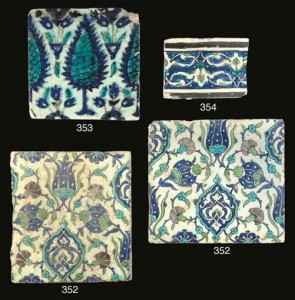
A tile similar to mine (no 353, top left) sold in an auction of Indian and Islamic works of art, Christie’s, London, 7 April 2006.
It’s not a perfect match—again, the ‘pine cone/fish scales’ are painted, unlike on my example, and as there are no details for the Christie’s example—size, country of origin, etc—I am not much nearer knowing. But it’s the best match yet.
In my searches I came across this example too, one of a pair:
which is not such a close match, but it’s the same design, albeit a rather fancier interpretation. This one is attributed to either a Damascus or Jerusalem manufacturer, and dating from later, from the 18th century. It shows how the design retained its popularity.
UPDATE 18 October 2015: A very kind gentleman, Peter Malone, left a comment on my second post about this tile, saying that he thought it was an 18th century Damascus tile, and that the motif was a stylised cypress tree. So that ties in with the general provenance being Syria rather than Turkey. He mentioned a newly-published book which might be of interest: Damascus Tiles: Mamluk and Ottoman Architectural ceramics from Syria by Arthur Millner, published on 1 September 2015 by Prestel, and said that a similar tile was recently offered for sale at Rosebery’s Auction house in London:
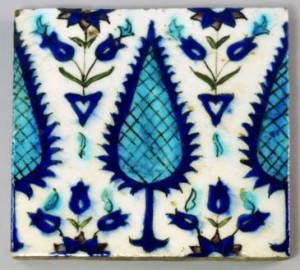
Tile for sale at Rosebery’s Auction house, London, 6 October 2015, described in the catalogue as ‘A Persian tile, 19th century, decorated with stylised foliage and leaves, 23 x 23cm’.
It’s the same design, but again, the treatment of the interior of the cypress tree (as I must now call it) is painted cross-hatching rather than raised bobbles as on mine. It’s also almost the same size as mine. Interesting!